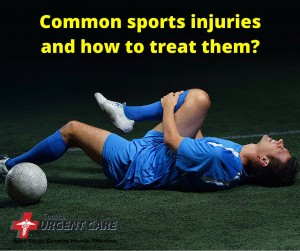 You might train harder and be more athletic than anyone else, but no one is immune to the possibility of sports injuries while you’re out there flexing your muscles. Sports injuries — like shin splints and ACL tears — can leave you on the bench and away from some of your favorite activities, especially if you’re not taking steps to avoid them.
You might train harder and be more athletic than anyone else, but no one is immune to the possibility of sports injuries while you’re out there flexing your muscles. Sports injuries — like shin splints and ACL tears — can leave you on the bench and away from some of your favorite activities, especially if you’re not taking steps to avoid them.
What are the most common sports injuries?
Sports injuries happen for a number of reasons, the most common being overusing and overstretching your muscles. Here are some of the sports injuries that happen most often:
- Ankle sprain – tearing of ligaments in ankle
- Groin pull – too much stress on muscles in your groin and thigh
- Hamstring strain – when you strain or pull your hamstring muscles, located in the back of your knee
- Shin splints – inflammation of muscles, tendons, and bone tissue around your shin
- Knee injury: ACL tear – the tearing of a major ligament in your knee
- Knee injury: Patellofemoral syndrome — injury resulting from the repetitive movement of your kneecap against your thigh bone
- Tennis elbow – elbow pain from overusing your arm, forearm and/or hand muscles
What do sports injuries mean for athletes?
When sports injuries do occur, not only are you in physical pain, the injuries can also induce psychological and emotional pain and suffering.
Some of these mental issues include:
- Depression
- Anxiety
- Disordered eating
- Substance abuse
Sometimes, there are less severe emotional responses to sports injuries, especially for student-athletes. These include:
- Sadness
- Isolation
- Irritation
- Lack of motivation
- Anger
- Frustration
- Changes in appetite
- Sleep disturbance
- Disengagement
How do you prevent and treat sports injuries?
Although sports injuries are not always unavoidable, there are some things you can do to try to prevent them. These steps include:
- Wear protective gear, such as helmets or pads. Helmets are useful for a variety of sports, including football, hockey, baseball, softball, biking, skateboarding, and inline skating.
- Warm up and cool down. Take a light jog before you start. You shouldn’t even start stretching before that jog.
- Know the rules of the game.
- Watch out for others.
- Don’t play when you’re injured.
If you tried all the above steps and still end up with a strain, sprain or something more severe, there are things you can do to alleviate the pain. There’s a widely used acronym that sums it up – RICE:
- Rest – Move as little as possible.
- Ice – Cold packs are your friends.
- Compression – Applying light pressure with a wrap can minimize swelling and bleeding.
- Elevation – Raise the affected area with pillows or other items so that the fluids drain to other parts of the body and relieve pressure on the injured area.
